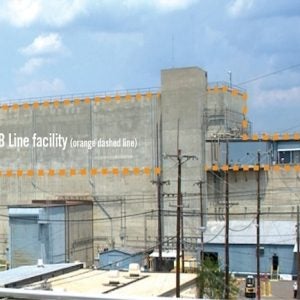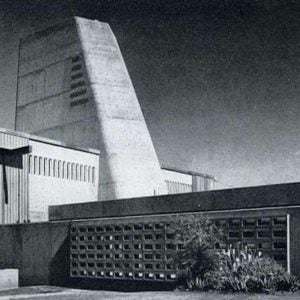Even if climate targets seem insurmountable, every single reactor means less demand for fossil fuel extraction and a step toward reducing carbon emissions, says Jeremy Gordon.
EARLY ON IN MY ENERGY career I learned that a lot of charts and graphs are presented at conferences, and in these charts the lines and the bars only ever go in one direction: up. Energy demand grows every year, so does population, so does GDP, so does the growth of renewables and so should the growth of nuclear energy.
So, indeed, do annual carbon dioxide emissions. Despite decades of meetings and pledges and investments and countless people’s entire careers, we’re emitting more carbon dioxide than ever before. The rate of increase doesn’t even seem to have fallen.
The only graphs where lines go downwards are in our hopes of reducing greenhouse gas emissions. They are heading towards zero by about 2050.
In Paris during 2015 our governments agreed to make this a reality, so that average warming would be limited to 2 degrees C or 1.5 degrees C if possible. This was never backed up by the right pledges, and the withdrawal of the USA certainly hasn’t helped, but it is now abundantly clear that there is no chance of achieving 1.5 degrees. The graphs show that if we keep emitting at the same rate as today the curve will need to be bent so violently as to be completely fantastical — an end to emissions virtually overnight. That is not going to happen, not least because trying to do so would kill even more people than the warming it avoids. Suddenly the far-off targets for emission reductions are on the doorstep, demanding their debts be paid.
If we have missed our chance to gradually reduce emissions, and also our chance for a drastic near-vertical drop, what options remain? We would either need machines to extract carbon dioxide out of the air on a massive scale, or a time machine to take us back to the 1970s when it would have all been so much simpler (and nuclear power was well positioned to scale up and do half the job).
Those of us who prioritise this — a group which I appreciate does not include all readers of this magazine — are having to face up to the fact we are going to sail straight past the event horizon for 1.5 degrees C with no physical means of reversing what we have done. With current technology we must believe the impacts of missing the opportunity will be felt by humanity for the rest of time. The weirdness of weather and documented impacts on species we know so far are only from 1 degree C of warming, and we are already resigned to 1.5 degrees C.
How does it feel for the growing number of people who consider they have already failed their children, and are failing them more every day? Say what you like about the veracity of that, more and more people are feeling that way. I have an awful feeling that as the years pass the Anthropocene, as the current geological period of time shaped by humans is called, will be so emotionally wearing on our species that we abandon serious efforts to stabilise temperatures roughly where they used to be.
Worse, I’m reminded of Truman Capote’s masterpiece non-fiction novel In Cold Blood, which explores the gruesome murder of the Clutter family on their farm in rural Kansas during a robbery.
One thread in the novel follows one of the culprits, Perry, all the way to Death Row, discovering his motives, while another slowly reveals the gory details of the crime itself. In the book’s climax we finally find out precisely what made Perry pull the trigger and kill the father, Herb Clutter: an impulse of unbearable shame in the moment Perry looked Herb in the eye and realised what he was doing to this honourable man and his family. The book’s genius is to anchor everything on this unspeakable human flaw; one that makes every single one of us vulnerable to imploding and throwing it all away when faced with the facts.
On this Earth, we are homo sapiens and our burden is to know what we are doing. I’m not the only one to have been reckoning with the 1.5 degree C event horizon. On social media, climate writer Mary Annaïse Heglar said, “I don’t care what thresholds we pass. I don’t care how much worse it gets. Giving up is immoral.” Michael Liebreicht, founder of Bloomberg New Energy Finance, added, “Plus, giving up would be economic and psychological self-harm.” Their words were followed by dozens of determined voices in agreement.
If facing our failure to reduce emissions demands increasing psychological strength, how about bending up the curve of nuclear generation? With more reactors under construction than at any time for ages, industry has managed 1-2% growth for the last few years and is back to the levels of generation it saw before the Fukushima accident. It has been a long nine years to stand still.
I’ll admit to occasional flashes of doubt about my own commitment to helping nuclear expand its role. It chronically under-performs and is in need of the kind of help I can give, but from time to time a setback makes me think, ‘What is the point in this? We are getting nowhere. Fantasies of fast reactors being rolled out globally? No chance! Don’t waste my time…’
In some countries, there is 360-degree criticism from the public, politicians and NGOs, with only a few unpaid independent advocates trying to make the case for nuclear. With such a lack of goodwill, and with no serious investment to generate any, there is no way any industry could perform to its best and overcome its challenges.
It would be tempting to give up on nuclear, and plenty of talented people have left the industry in frustration to work on something that moves a bit faster. I am prepared for the idea that ultimately nuclear might not be needed in the future clean energy system. But the state of technologies we currently use to exploit the handful of energy sources does not justify that conclusion now, nor for the foreseeable future.
Whether or not human beings ever manage to bend the graph of emissions down to zero, any reduction relative to current rates of environmental impact are worth making. The fact is that conservation values not only the qualities of the atmosphere but every strand in every ecosystem. They all need to be protected from needless damage and that remains true now and in the future, no matter how much damage may already have been done.
That’s why this industry has to keep on trying, for the multitude of benefits nuclear energy brings relative to the rest of the energy industry. Every nuclear reactor we manage to build means less demand for fossil fuel extraction, uranium mining by contrast being far lower impact. Consider that the largest uranium deposit in the world at Olympic Dam in Australia is mined only as a by-product of copper, and the largest uranium producing country, Kazakhstan, mines in-situ without even breaking the ground surface.
Every new reactor means zero-emission production of electricity, on a compact site usually surrounded by a virtually pristine natural environment. And that power generation will continue through 2050, avoiding environmental damage, as we sail past our net zero targets. It will continue past 2075, making its contribution even while we miss our targets. It will even be running and contributing to the targets for our grandchildren’s generation in 2100.
When I feel down, I remind myself that if my work helps a single reactor operate for a single extra year then I would have been part of a global team that helped avoid about 4 million tonnes of carbon dioxide emissions by that achievement alone, while supporting thousands of other people to live well. Readers of this magazine play a much more direct role than me. Helping avoid about 5000 times more carbon dioxide than we would have emitted in our entire lives would not be a bad contribution at this moment in history.
About the author: Jeremy Gordon is an independent communication consultant with 15 years of experience in the international energy industry. His company Fluent in Energy supports partners of all kinds to communicate matters of clean energy and sustainable development.
Cartoon by Alexey Koveynev: “Colleagues, we’ve found that over the past twenty years we have used an inverted graph. This is the correct one!"






